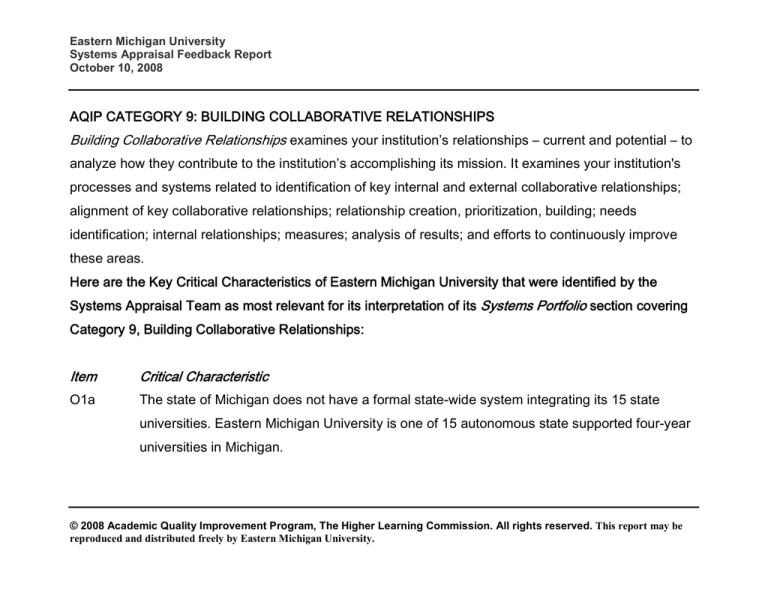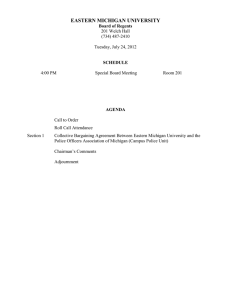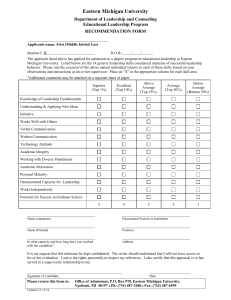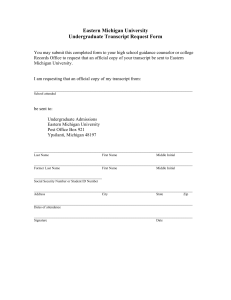
Eastern Michigan University Systems Appraisal Feedback Report October 10, 2008 AQIP CATEGORY 9: BUILDING COLLABORATIVE RELATIONSHIPS
Building Collaborative Relationships examines your institution’s relationships – current and potential – to
analyze how they contribute to the institution’s accomplishing its mission. It examines your institution's
processes and systems related to identification of key internal and external collaborative relationships;
alignment of key collaborative relationships; relationship creation, prioritization, building; needs
identification; internal relationships; measures; analysis of results; and efforts to continuously improve
these areas.
Here are the Key Critical Characteristics of Eastern Michigan University that were identified by the
Systems Appraisal Team as most relevant for its interpretation of its Systems Portfolio section covering
Category 9, Building Collaborative Relationships:
Item
Critical Characteristic
O1a
The state of Michigan does not have a formal state-wide system integrating its 15 state
universities. Eastern Michigan University is one of 15 autonomous state supported four-year
universities in Michigan.
© 2008 Academic Quality Improvement Program, The Higher Learning Commission. All rights reserved. This report may be reproduced and distributed freely by Eastern Michigan University. Eastern Michigan University Systems Appraisal Feedback Report October 10, 2008 O1d
Eastern Michigan University has embraced a commitment to contribute to the local
community in its core principles and strategic directions, demonstrated by more than 25,000
hours of student volunteer community service annually.
O1g
Eastern Michigan University has adopted five core principles and four strategic directions
that guide decision making, which emphasize learning, engagement with the community, and
diversity and multiculturalism.
O2b
Students have an opportunity to take classes and complete programs at seven off-campus
locations through Continuing Education.
O2d
Eastern Michigan University’s new General Education program includes a Learning Beyond
the Classroom component in which students are required to participate in extracurricular and
co-curricular activities.
O4a
Eastern Michigan University collaborates through accreditation agencies, businesses,
centers and institutions, targeted industry grants, research grants and agreements,
nonprofits, advisory boards and steering committees, community colleges, and K-12 districts.
O5a
Most of Eastern Michigan University’s employees are represented by unions. The nonunion
employees include administrative/professional, confidential clerical employees and coaches.
© 2008 Academic Quality Improvement Program, The Higher Learning Commission. All rights reserved. This report may be reproduced and distributed freely by Eastern Michigan University. Eastern Michigan University Systems Appraisal Feedback Report October 10, 2008 O7b
Eastern Michigan University has established 75 articulation agreements with 13 community
colleges, along with on-site baccalaureate programs at one community college. The
University considers community colleges partners as much as competitors.
Here are what the Systems Appraisal Team identified as Eastern Michigan University’s most important
strengths and opportunities for improvement relating to processes encompassed by Category 9, Building
Collaborative Relationships.
Item
S/O
9P1
SS
Comment
In the lack of any state-wide systematic mechanism for transfer, Eastern
Michigan University has established an Office of Community College Relations to
provide information to help students transfer.
9P1
S
Eastern Michigan University develops relationships using formal and informal
criteria and techniques. The criteria to identify and develop partners include the
following: Mutual benefit sustainability (long-term in nature), and significant
impact. These criteria allow Eastern Michigan University to select and work with
partners that align with the vision, mission, and values.
© 2008 Academic Quality Improvement Program, The Higher Learning Commission. All rights reserved. This report may be reproduced and distributed freely by Eastern Michigan University. Eastern Michigan University Systems Appraisal Feedback Report October 10, 2008 9P1
O
While Eastern Michigan University has developed and sustained a number of
important relationships with external constituents (Figure 9.1 and Appendix A),
some of the collaborative relationships are consequences of longstanding or
already existing relationships with feeder schools and community colleges or with
advisory boards and accrediting agencies. As such, these have mostly been
maintained, rather than developed. Others appear to involve specific, conscious
efforts to develop new linkages, as shown in the Academic Service- Learning
activities. While these relationships align with one or another aspect of the
mission, there does not appear to be a process by which collaborations are
specifically developed and prioritized.
9P2
O
Processes by which Eastern Michigan University ensures that the needs of
organizations with which to collaborate are met seem unevenly developed. Aside
from normal communication, there are no systematic methods for gathering
information about specific needs or their fulfillment. The University will be more
successful in securing feedback from its collaborators by developing regular and
consistent techniques and measures for this purpose.
© 2008 Academic Quality Improvement Program, The Higher Learning Commission. All rights reserved. This report may be reproduced and distributed freely by Eastern Michigan University. Eastern Michigan University Systems Appraisal Feedback Report October 10, 2008 9P3
S
Eastern Michigan University is often successful at developing internal
collaborations, particularly in the areas of Continuing Education and
interdisciplinary academic programs. The new planning methods are also
beginning to foster more internal collaborations. A focused effort to cultivate more
internal collaborations can help to reduce internal barriers and facilitate more
effective attainment of the mission.
9P4
S
The University has identified some measures by which it can assess the
effectiveness of its collaborative relationships. Information and feedback are
provided from various collaborators, particularly feeder schools and colleges,
along with advisory boards. Eastern Michigan University can strengthen its
feedback sources with more systematic information gathering, particularly in key
areas such as the service learning collaborators.
9R1
S
Eastern Michigan University has provided some results of its collaborative
relationships, which suggest that some new developments and improvements in
these relationships have been effective over time.
© 2008 Academic Quality Improvement Program, The Higher Learning Commission. All rights reserved. This report may be reproduced and distributed freely by Eastern Michigan University. Eastern Michigan University Systems Appraisal Feedback Report October 10, 2008 9R1
O
The results provided do not give enough information to analyze any trends. Also,
the results do not include data or information related to all the key collaborative
categories that were outlined in Figure 9.1.
9R2
O
No comparison data are available to allow Eastern Michigan University to
evaluate the effectiveness of its processes for collaborative relationships relative
to other institutions.
9I1-9I2
O
No improvement actions are reported.
© 2008 Academic Quality Improvement Program, The Higher Learning Commission. All rights reserved. This report may be reproduced and distributed freely by Eastern Michigan University.



